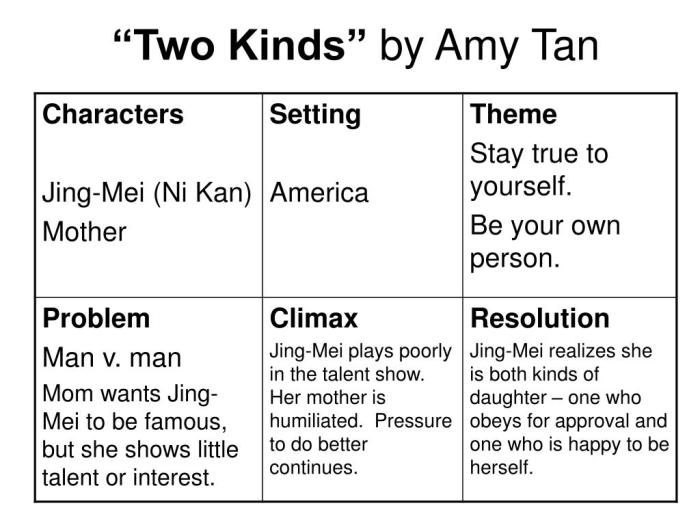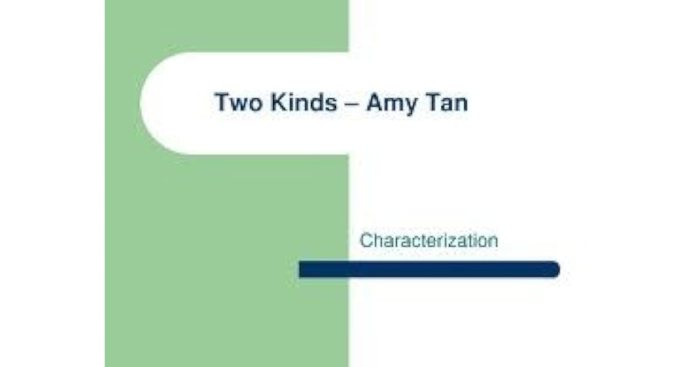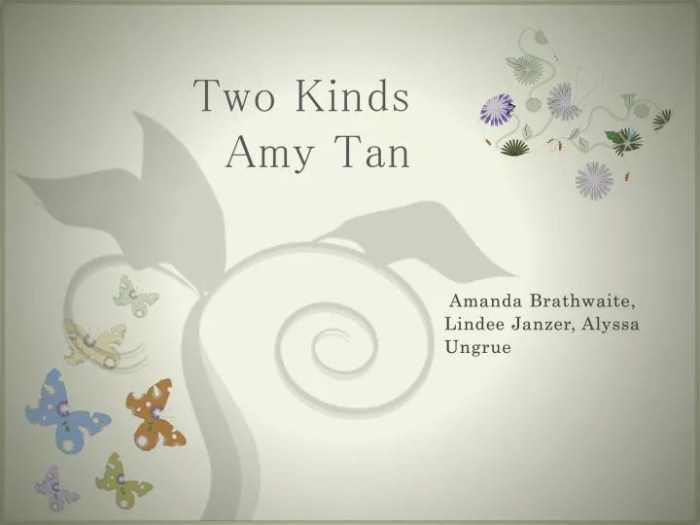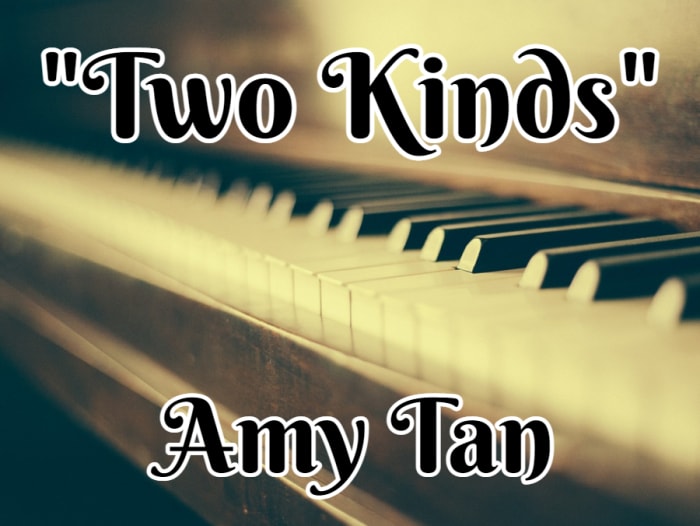Two kinds by amy tan pdf – Immerse yourself in the world of “Two Kinds” by Amy Tan, a captivating short story that delves into the complexities of cultural expectations, identity, and self-discovery. This literary masterpiece, available as a PDF, offers a profound exploration of the struggles faced by immigrants and their children.
Join Jing-mei Woo, the protagonist, as she navigates the clash between her Chinese heritage and American upbringing. Through her journey, we witness the challenges and triumphs of finding one’s place in a world where expectations and aspirations collide.
Introduction to “Two Kinds” by Amy Tan
Amy Tan’s “Two Kinds” is a poignant and evocative short story that explores the complex relationship between a Chinese-American mother and her daughter. The story delves into the themes of cultural identity, the pressure to conform, and the search for self-acceptance.
Amy Tan’s Background and Significance
Amy Tan is a renowned Chinese-American writer known for her insightful exploration of the immigrant experience and the challenges faced by Asian Americans. Her works, including “The Joy Luck Club” and “The Kitchen God’s Wife,” have received critical acclaim and have become widely studied in literature courses.
Character Analysis
Amy Tan’s “Two Kinds” presents a complex mother-daughter relationship between Jing-mei Woo and her mother, Suyuan Woo. This analysis explores their characters and the conflicts that arise from their cultural differences.
Jing-mei Woo
- Rebellious and independent:Jing-mei resists her mother’s expectations, pursuing her own interests in music and writing.
- Insecure and self-conscious:She struggles to live up to her mother’s high standards and feels a sense of inadequacy.
- Yearns for approval:Despite her rebellious nature, Jing-mei secretly craves her mother’s love and acceptance.
Suyuan Woo
- Traditional and ambitious:Suyuan holds strong cultural values and believes in the importance of education and success.
- Strong-willed and determined:She is a survivor who has overcome adversity and worked hard to provide a better life for her family.
- Uncompromising and demanding:Suyuan expects the best from her daughter and is often critical of her perceived shortcomings.
Conflicts and Tensions
- Cultural expectations:Suyuan’s traditional Chinese values clash with Jing-mei’s American upbringing, leading to conflicts over education, career, and life choices.
- Mother-daughter bond:Despite their differences, Jing-mei and Suyuan have a deep bond. However, this bond is often strained by misunderstandings and unresolved issues.
- Identity and self-discovery:Jing-mei struggles to reconcile her Chinese heritage with her American identity, while Suyuan’s past experiences shape her present.
Cultural Differences and Expectations

The story “Two Kinds” by Amy Tan highlights the cultural differences and expectations that exist between Jing-mei and her mother. Jing-mei’s mother is a Chinese immigrant who holds traditional values and believes in the importance of education and discipline. Jing-mei, on the other hand, is a second-generation Chinese American who has adopted more Western values and desires.
This clash of cultures leads to tension and conflict between mother and daughter.
Amy Tan’s “Two Kinds” explores the complexities of mother-daughter relationships, cultural expectations, and the search for identity. The novel’s themes resonate with readers of all ages and backgrounds, making it a valuable addition to any bookshelf. If you’re interested in learning more about the novel, you might also be curious about how to convert centimeters to inches.
For example, did you know that 173 centimeters is equal to 68.11 inches ? This conversion can be helpful for understanding the physical descriptions of characters in “Two Kinds” and other works of literature.
Role of Tradition and Modernity
The story explores the role of tradition and modernity in the lives of Chinese immigrants. Jing-mei’s mother clings to traditional Chinese values, such as the importance of family, respect for elders, and hard work. She believes that Jing-mei should follow in her footsteps and become a successful pianist.
Jing-mei, however, rejects these traditional values and embraces a more modern lifestyle. She wants to pursue her own interests and dreams, which include becoming a writer.
Significance of the Piano Lessons and the Mother-Daughter Relationship
The piano lessons are a symbol of the cultural divide between Jing-mei and her mother. Jing-mei’s mother sees the lessons as a way to ensure her daughter’s success and to fulfill her own unfulfilled dreams. Jing-mei, however, resents the lessons and sees them as a form of oppression.
The piano lessons become a source of conflict between mother and daughter, and they ultimately lead to Jing-mei’s rebellion.
Identity and Self-Discovery: Two Kinds By Amy Tan Pdf

Jing-mei’s journey of self-discovery is a complex one, shaped by the conflicting expectations of her mother and her own aspirations. From a young age, her mother projects her own unfulfilled dreams onto Jing-mei, pressuring her to excel in piano and become a prodigy.
However, Jing-mei struggles to meet these expectations, and her self-esteem suffers as a result.
Influence of Cultural Expectations
The cultural expectations of her Chinese heritage play a significant role in Jing-mei’s self-perception. Her mother believes that success and honor are paramount, and that her daughter’s worth is measured by her achievements. This pressure to conform to traditional values leads Jing-mei to question her own identity and to feel like an outsider in her own family.
Journey of Self-Discovery and Acceptance
As Jing-mei grows older, she begins to break free from her mother’s expectations and to explore her own interests. She discovers a passion for writing, which allows her to express her own voice and to find a sense of belonging.
Through her journey of self-discovery, Jing-mei learns to accept herself for who she is, regardless of her mother’s dreams.
Symbolism and Imagery

Tan employs rich symbolism and vivid imagery throughout “Two Kinds” to enhance the story’s themes and convey deeper meanings. The piano, the twins, and the ending all serve as powerful symbols that contribute significantly to the narrative.
The Piano
The piano represents the expectations and pressures imposed upon the protagonist, Jing-mei. It symbolizes her mother’s unwavering belief in her daughter’s musical talent and the burden of fulfilling her mother’s unfulfilled dreams. The piano’s harsh, unyielding keys reflect the relentless pursuit of perfection and the emotional toll it takes on Jing-mei.
The Twins, Two kinds by amy tan pdf
The twins, Jing-mei and her unnamed sister, embody the contrasting expectations and identities within the family. Jing-mei is seen as the “prodigy” with potential, while her sister is the “dutiful” one who meets her mother’s expectations. The twins represent the conflict between conforming to societal norms and embracing one’s true self.
The Ending
The story’s ending is a poignant and powerful symbol of Jing-mei’s journey of self-discovery. By finally breaking free from the constraints of her mother’s expectations, she discovers her own voice and identity. The “two kinds” she speaks of represent the duality within herself: the daughter who once conformed to expectations and the woman who now embraces her true nature.
Literary Techniques and Style

Amy Tan’s “Two Kinds” is a masterclass in literary craftsmanship. Tan employs a range of techniques to create a vivid and emotionally resonant narrative.
Figurative Language
Tan’s use of figurative language is both evocative and precise. Metaphors and similes abound, creating vivid images and conveying complex emotions. For instance, the piano is described as a “black, polished abyss” and a “monster” that “devoured” the narrator’s time and energy.
Structure and Narrative Style
The story is told in a non-linear fashion, with flashbacks and shifts in perspective that create a sense of complexity and depth. The narrator’s voice is at once intimate and detached, providing a unique insight into her inner struggles.
Point of View and Voice
The story is told from the first-person perspective of the narrator, allowing readers to experience her thoughts and emotions directly. Tan’s use of voice is particularly effective in capturing the narrator’s sense of alienation and her struggle to find her own identity.
Themes and Interpretation

Amy Tan’s “Two Kinds” explores the complex and often conflicting themes of identity, culture, and family. The story revolves around the protagonist Jing-mei’s struggles to reconcile her Chinese heritage with her American upbringing.
One of the central themes of the story is the tension between cultural expectations and personal identity. Jing-mei’s mother, a traditional Chinese immigrant, expects her daughter to excel in traditionally feminine pursuits such as the piano and chess. However, Jing-mei’s interests lie elsewhere, and she resents her mother’s attempts to force her into a mold that does not fit her.
Interpretations of the Ending
The story’s ending is ambiguous and open to interpretation. Some readers believe that Jing-mei ultimately reconciles with her mother and accepts her Chinese heritage. Others believe that she remains alienated from her mother and her culture.
Relevance to Contemporary Society
“Two Kinds” remains relevant to contemporary society, as it explores the challenges faced by individuals who are trying to navigate between different cultures and expectations. The story highlights the importance of self-acceptance and the need to find one’s own path in life.
FAQ Corner
Where can I find a PDF of “Two Kinds” by Amy Tan?
You can find a PDF version of “Two Kinds” by Amy Tan online or through reputable booksellers.
What is the main conflict in “Two Kinds”?
The main conflict in “Two Kinds” centers around the clash between Jing-mei’s Chinese heritage and her American upbringing, leading to a strained relationship with her mother.
What is the significance of the piano in “Two Kinds”?
The piano represents Jing-mei’s mother’s hopes and expectations for her daughter, as well as the cultural divide between them.
